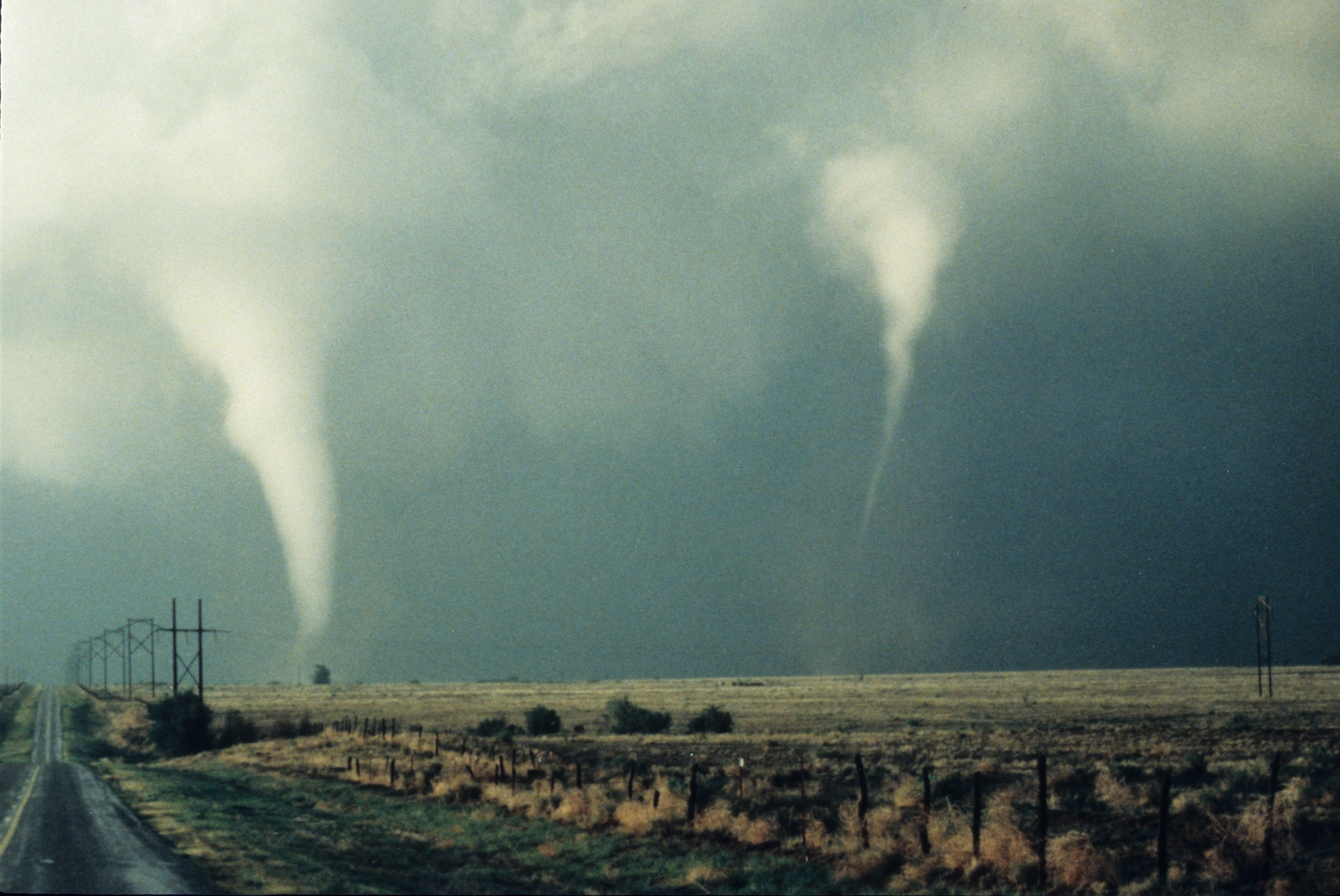Tornado Family on:
[Wikipedia]
[Google]
[Amazon]
 A tornado family is a series of
A tornado family is a series of
 A tornado family is a series of
A tornado family is a series of tornado
A tornado is a violently rotating column of air that is in contact with the surface of Earth and a cumulonimbus cloud or, in rare cases, the base of a cumulus cloud. It is often referred to as a twister, whirlwind or cyclone, although the ...
es spawned by the same supercell
A supercell is a thunderstorm characterized by the presence of a mesocyclone, a deep, persistently rotating updraft. Due to this, these storms are sometimes referred to as rotating thunderstorms. Of the four classifications of thunderstorms (su ...
thunderstorm. These families form a line of successive or parallel tornado paths and can cover a short span or a vast distance. Tornado families are sometimes mistaken as a single continuous tornado, especially prior to the 1970s. Sometimes the tornado tracks can overlap and expert analysis is necessary to determine whether or not damage was created by a family or a single tornado. Oftentimes, tornadoes are small and don’t make it far before dying out. However, large tornadoes are also present in many situations that track for very long distances. To determine the average track length of a tornado, both of these factors must be taken into account. The average track length for a typical tornado is about 1–2 miles, but they can vary from as little as a few feet to over 100 miles.
In some cases, such as the Hesston-Goessel, Kansas tornadoes of March 1990, different tornadoes of a tornado family merge, making discerning whether an event was continuous or not more difficult.
Some tornado damage remains a mystery even today due to a lack of evidence. The Tri-State Tornado
In the midday and afternoon hours of Wednesday, March 18, 1925, the deadliest tornado in United States history and second-deadliest worldwide moved through Eastern Missouri, Southern Illinois and Southern Indiana, killing 695 people and inj ...
of March 1925 was one such event. It could either have been the longest single tornado recorded or a family of tornadoes. A thorough re-analyses project found that it was probably one continuous tornado for most of its path, likely bounded by separate tornadoes at the beginning and end of the very long track (VLT) tornado, and likely another significant tornado spawned many miles later. However, many other exceptional VLT events were later found to be tornado families with much shorter tornado path segments than originally thought, notably the Woodward, Oklahoma tornado family of April 1947 and the Charleston–Mattoon, Illinois tornado family of May 1917.
Tornado families can be a result of satellite tornadoes, cyclic tornadogenesis, or some combination thereof. Intense downburst
In meteorology, a downburst is a strong downward and outward gushing wind system that emanates from a point source above and blows radially, that is, in straight lines in all directions from the area of impact at surface level. It originate ...
s may also cause damage paths to appear continuous, although this was more an issue for historic tornadoes as such damage usually is now distinguishable as caused by straight-line winds. Especially when newly forming, tornadoes may sometimes exhibit brief breaks in the damage path even as the parent circulation is continuous. Such events may be considered as "skipping
Skipping may refer to:
* Skipping (gait), a rhythmic form of locomotion combining stepping and hopping
* A game or form of exercise using a skipping rope
* Exon skipping, in molecular biology
* Stone skipping, throwing a stone so that it bounces ...
", a term that originally referred to what now is typically a tornado family. Successive tornadoes may be considered by some as separate tornadoes (and thus constituting a tornado family) only when spawned by a new tornadocyclone or low-level mesocyclone
A mesocyclone is a meso-gamma mesoscale (or storm scale) region of rotation ( vortex), typically around in diameter, most often noticed on radar within thunderstorms. In the Northern Hemisphere, it is usually located in the right rear flank ( ...
(and from within a new wall cloud
A wall cloud (murus or pedestal cloud) is a large, localized, persistent, and often abrupt lowering of cloud that develops beneath the surrounding base of a cumulonimbus cloud and from which tornadoes sometimes form. It is typically beneath the ...
).
See also
*Tornado outbreak
A tornado outbreak is the occurrence of multiple tornadoes spawned by the same Synoptic scale meteorology, synoptic scale weather system. The number of tornadoes required to qualify as an outbreak typically are at least six to ten, with at least ...
* Tornadogenesis
Tornadogenesis is the process by which a tornado forms. There are many types of tornadoes, varying in methods of formation. Despite ongoing scientific study and high-profile research projects such as VORTEX projects, VORTEX, tornadogenesis is a ...
* Tornado intensity
Tornado intensity is the measure of wind speeds and potential risk produced by a tornado. Intensity can be measured by In situ#Earth and atmospheric sciences, ''in situ'' or remote sensing measurements, but since these are impractical for wide- ...
References
US Department of Commerce, NOAA. “Tornadoes FAQ.” National Weather Service, NOAA’s National Weather Service, 13 June 2015, www.weather.gov/lmk/tornadoesfaq#:~:text=Path%20lengths%20can%20range%20from,tornadoes%20occasionally%20can%20be%20violent. {{DEFAULTSORT:Tornado Family Tornado Tornadogenesis